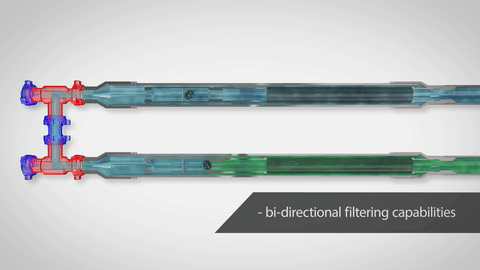Drillpipe Debris Trap Deck Unit
Current pit trash and well trash filtering systems require expensive consumables, multiple units based on flow direction, and personnel to run. The DPDT-DU is a 15ksi rated active bi-directional surface filter meant to be unmanned and out of the way.
Drillpipe Debris Trap deck unit - features
Screens may be customized to filter as tight as desired without stripping weighting agents.
No daily consumables.
Continuous pressure monitoring.
Bi-directional capability eases rig up and increases functionality.
Remote display allows operator to read presence of debris in unit remotely.
Frequently Asked Questions
Does the DPDT-DU have any consumables?
The DPDT-DU does not have any consumable products. The screens utilized are a one-time purchase if the gauge desired is not in inventory. Provided the screens are returned undamaged, they are cleaned, inspected, and utilized for subsequent operations.
What is the debris capturing capacity?
The DPDT-DU can hold approximately between 0.6bbls and 0.8bbls of solidly packed debris. The ability for Spoked to customize as per clients’ needs, however, means that configuration can be accommodated to adjust this volume as required.
How do you know when the unit is plugging or full?
The DPDT-DU barrels are ported for fluid gauges and/or digital gauges. Prior to operations and when circulating clean fluid, an initial pressure drop across the unit is documented at each of the four pressure gauge locations (this is also a good indication of surface line back pressure). During operations and while monitoring the gauges, delta P between any two gauges would indicate plugging in that area.
Can I flush the unit while operating?
Based on the rig up configuration, the DPDT-DU may be flushed while pumping through a unit or while bypassing the unit. The Gen-4 has an onboard pump for backflushing on-the-fly.
Can I bypass the unit if it plugs?
Yes, both the Gen-3 and Gen4 units have a built in bypass line.
What are the end connections?
The standard end connections are 3” 1502 WECO. However, the DPDT-DU barrels are 7inch diameters, thus crossover to 4” or another size connection is feasible upon request.
How fast can I pump through the unit?
The DPDT-DU rate capacity is limited by the high-pressure iron connected to it or the desired pressure drop across the unit. 20bpm is typical for one unit with 3” high-pressure iron. Larger diameter high-pressure iron may be utilized or multiple deck units may be rigged up to increase rate capacity.
What size debris can I filter?
The wire wrap screens supplied are 6gauge or larger. To filter below 6gauge, we utilize mesh screens.
What if I only want to pump one direction?
The DPDT-DU may be configured to pump in a single direction. This configuration creates the opportunity for the unit to have a primary and backup filtering option.
How big is the unit? What are the dimensions?
The DPDT-DU Gen-2 is 4ft wide x 3.5ft high x 12ft long. The DPDT-DU Gen-3 is 4ft wide x 5.5ft high x 8ft long. The DPDT-DU Gen-4 - please contact Superior Performance for latest.
Can I tear the unit down on location?
Yes, the unit does not require torqueing to be reassembled. Once made up, seals and set screws ensure proper makeup. Otherwise, 3" 1502 Weco connections make the connections.
Can I have multiple screen gauges?
Yes. The DPDT-DU may be customized with different screen gauges in each barrel or with multiple screen gauges in each individual barrel.
Can you create a multi-barrel cluster for pumping in a single direction?
Yes, the form factor of the deck unit may be designed such that greater than two barrels can be accommodated. Space allocation would need to be verified prior to creating this unit.
How long is needed to prepare a unit for mobilization?
Wnen requested for mobilization, approximately three days is needed when screens are in inventory and approximately 5 days when the screens are not in inventory. Expedited prep may also be accommodated.
Where is the DPDT-DU typically placed?
It is typically recommended that placement is between high pressure pumps and the standpipe manifold; however, it may also be placed upstream of pumps if filtering wellbore fluid is not desired. The unit is extremely flexible and not following this recommendation does not alter performance.
What has been captured before?
Rocks, formations and gravel pack sand, cement, annular rubber, plastics, leaves, sticks, metal, weighting agent, etc.
Have you ever completely plugged a unit?
No.
How does back-flushing work?
In the event flushing is required, the barrels may be redirected to a DCB, a shaker system, or a similar system identified by the rig crew for capturing debris for inspection or disposal. Pre-rig up for diverting to these systems is recommended to eliminate re-pressure testing the system; however, it is not required. When flushing the barrels, the flow path would appear as depicted in the diagram below (B side example).
Note that flushing while operating is design to return the unit to such a state that it may be utilized again without tearing it down. Back flushing is not as effective as a tear-down. The higher the rate during back-flushing the better.






